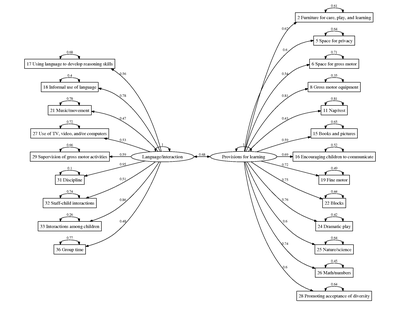I followed up the exploratory factor analysis (EFA) of the Early Childhood Environment Rating Scale (ECERS-R) with a confirmatory model comparison of the six-, two-, and one-factor solutions. The six-factor specification adhered to the original subscales in the ECERS-R instrument (after dropping highly skewed items); the two-factor specification simply restricted the minor loadings from the EFA to zero; and the one-factor specification restricted items to zero if they loaded less than |0.3| in the one-factor EFA solution.
The six-factor model did not converge, and the two-factor model exhibited better fit than the one-factor model. These results support earlier findings by Sakai and colleagues (2003) and Cassidy and colleagues (2005) that the ECERS-R measures two latent factors: provisions for learning and language/interaction experienced by children.
The goal of this analysis was to find a factorially simple solution. Higher order or hierarchical models of greater complexity would be worth considering in light of evolving theories and needs surrounding measures of child care quality and given that:
- several ECERS-R items cross-loaded in the EFAs and were subsequently excluded
- the overall fit of the two-factor model was poor
- the estimated correlation between the latent factors was somewhat large (0.68).
Comparison of one- and two-factor models
| CFA fit measure | One factor | Two factors |
| Model χ2 | 750, df = 377, p < 0.01 | 306, df = 208, p < 0.01 |
| χ2 (null model) | 1139, df = 406 | 653, df = 231 |
| Goodness-of-fit index | 0.509 | 0.645 |
| Adjusted goodness-of-fit index | 0.433 | 0.569 |
| RMSEA index | 0.164 | 0.113 |
| Bentler-Bonnett NFI | 0.341 | 0.532 |
| Tucker-Lewis NNFI | 0.452 | 0.742 |
| Bentler CFI | 0.491 | 0.768 |
| SRMR | 0.115 | 0.107 |
| BIC | -621 | -451 |

